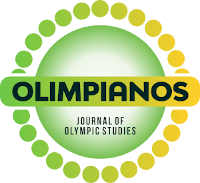Eco-deporte en el espacio de la ciudad moderna
DOI:
https://doi.org/10.30937/2526-6314.v5.id127Palabras clave:
deporte para todos, deporte urbano, ciudad deportiva, ciudad sustentableResumen
El propósito del artículo es revisar las tendencias actuales en soluciones espaciales urbanas y programas de activación deportiva a partir de ejemplos en ciudades seleccionadas. Una infraestructura deportiva atractiva que incentive la recreación al aire libre y cercana al lugar de residencia es un desafío importante para que los países reduzcan los estilos de vida sedentarios, especialmente para los jóvenes y poblaciones especiales (como indígenas e inmigrantes), además de promover la integración social de todos los grupos de edad.
Descargas
Citas
Hall CM. Sport tourism and urban regeneration. In: Ritchie BW, Adair D. (eds). Sport tourism: interrelationships, impacts and issues. Bristol (UK): Channel View Publications; 2004.
Schut P. Outdoor activities and urbanization: a constant bridging throughout the twentieth century in France. The International Journal of The History of Sport. 2017; 34(14):1521-1540. Doi: 10.1080/09523367.2018.1473381.
Rzegocinska-Tyzuk B. Przestrze? sportu w mie?cie-aspekt oszcz?dno?ci. Czasopismo Techniczne. Architektura. 2010;107(6-A/2):109-118.
Ross W, Leopkey R. The adoption and evolution of environmental practices in the Olympic Games. Managing Sport and Leisure. 2017;22(1):1-18.
Cantelon H, Letters M. The making of the International Olympic Committee environmental policy as a third dimension of the Olympic Movement. International Review for the Sociology of Sport. 2000;35(3):294-308.
Trendafilova S, McCullogh B, Phafl M, Nguyen S, Casper J, Picariello M. Environmental sustainability in sport: current state and future trends, Global Journal of Advances in Pure & Applied Sciences. 2014; 3:9-14.
Chappelet J-L. Olympic environmental concerns as a legacy of the Winter Games. The International Journal of the History of Sport, 2008; 25(14):1884-1902.
Omorczyk A. Olympic Games and new sport, recreation and leisure spaces for the local community. Folia Sociologica. 2020;75:121-131.
Smith A. Reimaging the city: the value of sport initiatives. Annals of Tourism Research. 2005; 32(1): 217-236.
Coalter F, Allison M, Taylor J. The role of sport in regenerating deprived urban areas, Edinburgh: HMSO; 2000.
Yuen B. Sport and urban development in Singapore, Cities. 2008;25(1): 29-36.
Friedman M, Andrews DL, Silk ML. Sport and the façade of redevelopment in the postindustrial city. Sociology of Sport Journal. 2004;21(2):119-139.
Rzegocinska-Tyzuk B. Sport w krajobrazie miasta – wybrane zagadnienia roli i kompozycji. Architecture. 2012; 109(1-A/2):145-156.
Kostrzewska M. Sport dla wszystkich w przestrzeni miasta – Raport dla Ministerstwa Sportu i Turystyki [cited 20 jul 2021]. Poland: Ministry of Sport and Tourism of the Republic of Poland; 2016. Available at: https://www.msit.gov.pl/download.php?s=1&id=12249.
Nols Z, Haudenhuyse R, Spaaij R, Theboom, M. Social change through an urban sport for development initiative? Investigating critical pedagogy through the voices of young people, Sport, Education and Society. 2019;24(7):727-741.
Cantin-Brault A. The reification of Skateboarding. International Journal of Sport Culture and Science. 2015;3(1):54-66.
Vermeulen J. The bridge as playground: organizing sport in public space. Culture and Organization. 2011;17(3):231-251.
Malchrowicz-Mosko E, León-Guereño P, Tapia-Serrano MA, Sánchez-Miguel PA, Wa?kiewicz Z. What encourages physically inactive people to start running? An analysis of motivations to participate in Parkrun and City Trail in Poland. Frontiers in Public Health. 2020; 8:1-9.
Descargas
Publicado
Número
Sección
Licencia
Los autores autorizan a otros a copiar y redistribuir el material en cualquier medio o formato. Remezcla, transforma y crea a partir del material. No puede utilizar el material con fines comerciales.






